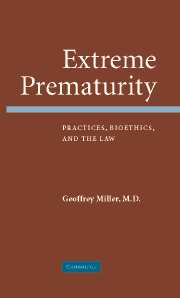Book contents
- Frontmatter
- Contents
- Part 1 THE EXTREMELY PRETERM INFANT: EPIDEMIOLOGY, PERCEPTIONS, AND PRACTICES
- 1 Introduction
- 2 Historical Aspects
- 3 Survival
- 4 Influence of Obstetric Management
- 5 Effect of Resuscitation in the Delivery Room
- 6 National Comparisons
- 7 Prediction of Outcome
- 8 Limit of Viability
- 9 Morbidity
- 10 School Age Outcome
- 11 Adolescence
- 12 Perceptions and Practices
- 13 Resource Expenditure
- Part 2 BIOETHICS
- Part 3 REPORTS, OFFICIAL OPINIONS, AND GUIDELINES
- Part 4 THE LAW
- Part 5 EPILOGUE: TRUTH, TRUST, AND BOUNDARIES
- References
- Index
4 - Influence of Obstetric Management
Published online by Cambridge University Press: 23 September 2009
- Frontmatter
- Contents
- Part 1 THE EXTREMELY PRETERM INFANT: EPIDEMIOLOGY, PERCEPTIONS, AND PRACTICES
- 1 Introduction
- 2 Historical Aspects
- 3 Survival
- 4 Influence of Obstetric Management
- 5 Effect of Resuscitation in the Delivery Room
- 6 National Comparisons
- 7 Prediction of Outcome
- 8 Limit of Viability
- 9 Morbidity
- 10 School Age Outcome
- 11 Adolescence
- 12 Perceptions and Practices
- 13 Resource Expenditure
- Part 2 BIOETHICS
- Part 3 REPORTS, OFFICIAL OPINIONS, AND GUIDELINES
- Part 4 THE LAW
- Part 5 EPILOGUE: TRUTH, TRUST, AND BOUNDARIES
- References
- Index
Summary
How physicians, in particular obstetricians, view and assess viability can affect perinatal survival figures. In an American study(44) that examined the relationship between obstetric care during labor and delivery and the survival of EPTIs, the authors compared the outcomes of those who were considered viable antenatally and those who were not. The factors evaluated in the judgment of viability were estimated age (>26 weeks) and estimated weight (>650g), lethal anomalies, and parental requests. In the total population studied, some were misclassified (usually weight estimation), or parents had requested aggressive management or the opposite. This “allowed” the authors to study the survival of infants who, by their standards, would have been considered nonviable but who received antenatal and perinatal care as if they were viable. Although in some groups the numbers were small, the chances of survival were strongly associated with the antenatal assessment of viability. The odds of survival for all fetuses treated as viable were 17 times the odds for those considered nonviable. Birth weight alone did not explain wholly the relationship between antepartum viability assessment and outcome. Thus, in this study, survival of the EPTI was related to judgments of viability that determined their care. Silver et al. also published similar findings.(45) These studies, which had relatively small numbers, do not suggest that there is no limit to fetal viability, but they do caution the reader to take into account obstetric management strategies when examining figures concerning the outcome of the EPTI.
- Type
- Chapter
- Information
- Extreme PrematurityPractices, Bioethics and the Law, pp. 16 - 17Publisher: Cambridge University PressPrint publication year: 2006



